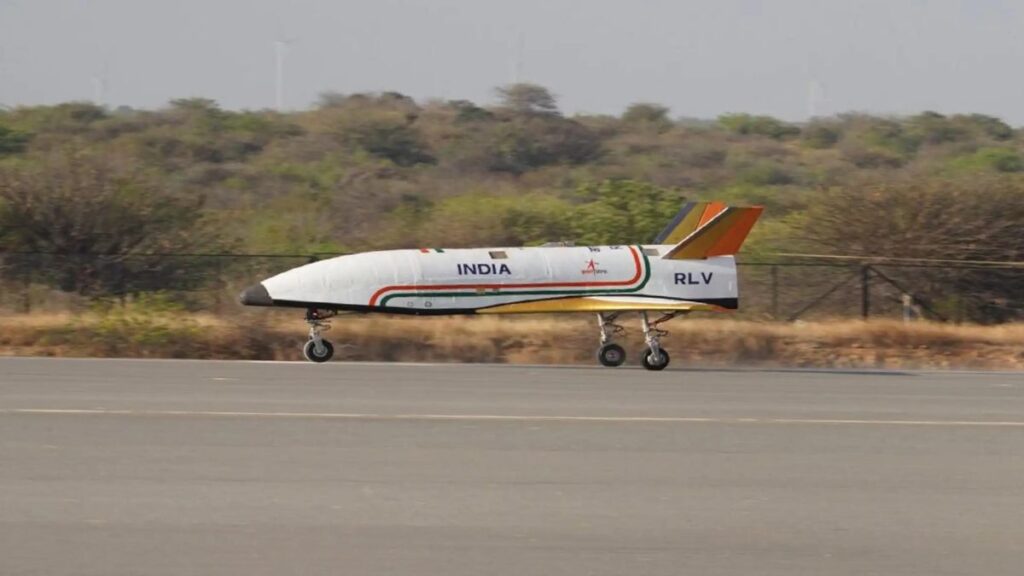India is developing a reusable launch vehicle (RLV) to reduce the cost and increase the frequency of space missions. The RLV is a two-stage-to-orbit (TSTO) vehicle that consists of a reusable orbiter and a disposable booster. The orbiter can glide back to Earth after delivering its payload to orbit, while the booster falls into the ocean. The RLV is expected to replace the current launch vehicles such as PSLV, GSLV and LVM3 in the future.
On April 2, 2023, ISRO successfully tested the landing of a reusable rocket that can launch again and again. This is part of the RLV-TD project that aims to make space missions cheaper and greener.
ISRO conducted a landing test at the Aeronautical Test Range in Challakere, Chitradurga. The RLV was released from an Indian Air Force Chinook helicopter at 4.5 km altitude. The vehicle autonomously executed approach and landing maneuvers on the runway, simulating conditions similar to a space re-entry—high speed and without human intervention, ensuring a stable landing.
The positive outcome of this test is another significant step for ISRO in its goal to create a fully reusable launch vehicle, aligning with its vision for cost-effective space access.
Currently, ISRO operates three active launch vehicles: the Polar Satellite Launch Vehicle (PSLV), the Geosynchronous Satellite Launch Vehicle (GSLV), and the Launch Vehicle Mark-III (LVM3). The PSLV consists of four stages, while the GSLVs have three stages each, with each stage using different fuel and being discarded when it’s depleted during the rocket’s ascent.
Understanding Reusable Launch Vehicles
Reusable launch vehicles (RLVs) are transforming satellite internet technology, bringing a significant shift in how satellites are launched and managed in space. These advanced spacecraft offer multiple benefits compared to the conventional expendable launch vehicles (ELVs).
RLVs stand out for being budget-friendly. Unlike ELVs that are used once and thrown away, RLVs can be used multiple times, slashing the overall expense of satellite launches. This is crucial in the satellite internet sector, where deploying numerous satellites for global coverage is essential. Thanks to the reduced launch costs, RLVs make it more financially feasible for companies to create and maintain satellite constellations, ultimately bringing down the cost of internet access for people worldwide.
Apart from saving money, RLVs provide added flexibility in launching satellites. Unlike ELVs, which launch one satellite at a time, RLVs can carry multiple satellites in a single launch, making the deployment of a full constellation more efficient. This not only speeds up the process but also lowers the risk of mission delays caused by weather or technical problems. The capability to deploy more satellites quickly gives satellite internet providers a competitive advantage in the fast-paced telecommunications market.
Moreover, RLVs simplify satellite upkeep and improvements. In the past, malfunctioning or outdated satellites lingered in orbit, leading to resource waste and space debris. RLVs change this by allowing the retrieval and repair or replacement of satellites, prolonging their useful life and decreasing space clutter. This feature is especially crucial in the satellite internet field, where frequent updates and upgrades are needed to match technological progress and changing user needs. RLVs enable staying current, ensuring satellite constellations can provide up-to-date and high-speed internet services.
RLVs offer an added benefit by paving the way for reusable spaceplanes. These space vehicles, operating like airplanes with takeoff and landing capabilities, have the potential to bring about a revolution in satellite deployment and maintenance. By doing away with expensive and intricate rocket launches, spaceplanes could significantly cut down the cost of reaching space. Additionally, they could offer a more effective way of deploying and bringing back satellites, as well as transporting people and equipment to and from space. Although still in the experimental phase, the progress in reusable spaceplanes holds great promise for the future of satellite internet technology.
To sum up, reusable launch vehicles are changing the satellite internet scene through cost savings, more flexibility, simpler maintenance and upgrades, and the possibility of reusable spaceplanes. These benefits are boosting the expansion of satellite constellations and lowering the cost of internet access. As technology progresses, it’s evident that RLVs will be crucial in shaping the future of satellite internet, making fast connectivity more reachable and budget-friendly for people globally.

